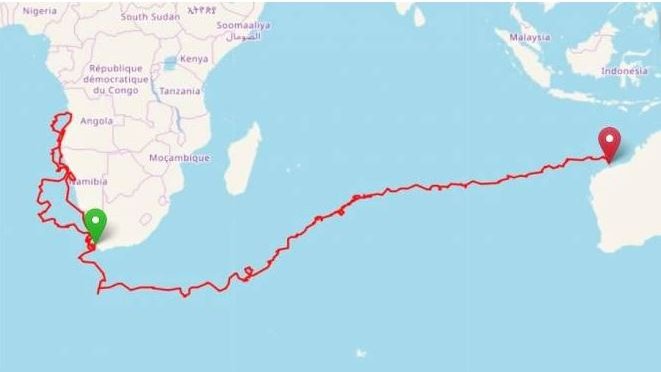A loggerhead turtle called Yoshi has been the subject of intense interest recently as her satellite transmitter has lasted for over two years providing valuable information on loggerhead biology.
This remarkably successful rehabilitation story has watched Yoshi the loggerhead travel 37 000 kilometres over two years since her release.
Yoshi was found as a 2kg juvenile by Japanese fishermen off the coast of South Africa in 1997 and taken to the Two Oceans Aquarium in Cape Town for rehabilitation.
Yoshi spent the next 20 years being cared for at the aquarium, where they taught her to come to a target for food so that she would not harass all divers in her exhibit for food.
The Aquarium learned a lot from caring for Yoshi and has since rehabilitated hundreds of turtles and released them to the wild.
Having grown to 180kg and believed to be at sexual maturity, with many decades of life ahead of her, the aquarium decided it was time to release Yoshi back to the wild as well.
Yoshi went into fitness training to prepare her for release, swimming 20m lengths to divers with targets at each end of her exhibit.
She was released, equipped with a satellite tracker in December 2017. The tracker has shown that she covered about 48km per day.
Over the past two years, she has travelled 37 000 kilometres up the west coast of Africa and back down again, around the southern tip and then across the Indian Ocean to the Pilbara coast.
“We are not 100% sure yet if Yoshi is Australian but her sudden directed movements towards our shore suggest she might have followed this route before.
Two weeks ago, she did a 90 degree turn and headed straight towards the coast. Since then, she has been swimming in very shallow waters, has slowed down drastically, and we therefore suspect she might have found some yummy food.
“Yoshi weighed 180 kg when she left the aquarium, which is on the heavy side for a loggerhead turtle, but a crossing of the Indian ocean swimming 50 km per day is probably a good fitness training and she was probably quite hungry when she arrived in Australian waters. Loggerheads eat mainly shellfish.” Research Scientist, Dr Sabrina Fossette said.
As Yoshi seemed to be in an accessible area a team of two scientists, two fisheries officers, an ABC reporter and a Traditional Owner from Ngarluma Aboriginal Corporation set out to try to find her on Monday and Tuesday 16-17 March.
Conditions were ideal and they were able to locate the area that Yoshi’s satellite tag was transmitting from.
Even with a regular update from the satellite, finding a turtle in the open ocean is a bit like trying to find a needle in a haystack! However, the crew did locate a large bale of loggerhead turtles feeding in the area.
There were adults and juveniles – the crew had about 40 sightings (some may have been the same animal more than once), which is very rare. The loggerheads were wary of the boat, so did not come within catching distance.
It was an area with rocky reefs and algae, and large numbers of loggerheads suggest it is great foraging habitat.
The team did not sight Yoshi unfortunately, but she has made it across the ocean and has been able to locate some friends and quality feeding ground to rest up and replenish her energy reserves.
“We did not know of any high quality loggerhead foraging habitat in Western Australia, that supported high densities of turtles. – Yoshi has shown us one of these locations and it possible that further searches of the region could find more.
Yoshi’s location is remote, has very little coastal development and little boat traffic. It is a dark part of the coast and would have good water quality. It is great to know that Yoshi is in an area with few threats.” Principal Research Scientist, Dr Scott Whiting.
Yoshi’s transmitter is still working, but is nearing the end of its battery life. Since last week she has remained close to the coast, and the positions that she has transmitted from might suggest she is looking at some of the local nesting beaches.
Scientists are weighing up the options of making another attempt to capture Yoshi:
“We understand that the current transmitter will be towards the end of its battery life and it would be great to replace it. Another piece of the puzzle is a DNA sample that will determine if Yoshi was born in Western Australia.
Yoshi’s behaviour, indicated by the handheld Argos Receiver, showed that she only remained at the surface for about a few seconds to 40-50 seconds, even without the presence of the boat. Even sighting Yoshi may not mean that we can catch her easily.” Dr Scott Whiting said.
With satellite tracking technology, there is proof that turtle rehabilitation was successful, and the time, effort and resources of rehabilitation centres had a positive impact.
Finding out more about other stages in the life history of turtles is essential to be able to understand and protect other important areas that they may be using. Yoshi has given us new insights into areas that are used by loggerheads and she has demonstrated how incredibly resilient these animals can be.

